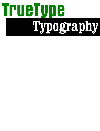
Is TrueType's superior behaviour on-screen going to mean Type 1 withers and dies? Or will Type 1's greater acceptance in the printing industry and Adobe's continually updated rasterizer mean that TrueType is remembered as a valiant, but too-late, contender for fontological supremacy?
In fact, both are now very firmly established and, with their 1996 announcement of OpenType, Microsoft and Adobe have jointly declared they intend neither to happen.
Let's compare them on the two basic criteria for scalable font technologies: outlines and hinting.
Outlines
Type 1Graphic designers who use computers are much more familiar with the cubic Bézier curves throughout PostScript (and hence Type 1 fonts) than TrueType's quadratics. Designers routinely use cubic curves to represent all the curves they care to. (Adobe Illustrator, Macromedia Freehand and CorelDraw, to take probably the three commonest applications, use cubic curves exclusively.)
TrueType
However, some of those who have used the rare software that allows native editing of TrueType curves say that its quadratic outlines are easier to manipulate than cubics. (FontLab 3.0 is the only font editor that allows quadratic outline editing. Indeed, there's no other graphics program that offers it.) Of course quadratic curves cannot represent all cubic curves (the reverse is true). But TrueType has capabilities making continuous curves easy and efficient, which PostScript makes more fiddly.
Hinting
Type 1At first sight, Type 1's hints are pretty easy to understand. The specification advises the font designer to declare hints for all vertical and horizontal "stem-like features" (either a vstem or an hstem). These identify zones to Type 1 rasterizing programs, such as ATM and PostScript printers, so that (unspecified) special techniques may be applied to these parts during the outline-filling process.
Although a font with well-defined hints will certainly rasterize much better than one without, it is not possible to specify precisely which pixels will be turned on, even for a particular size and device. This is for two reasons: first, although Type 1 is an open format, Adobe does not publish the specification of the Type 1 rasterizer, so clones and updated versions of PostScript may not produce identical bitmaps; second, from time to time Adobe updates the behaviour of its rasterizer.
Because the same hint always performs the same function, hints are easy to extract from the font file to edit visually along with the outline.
TrueType
Since it is a genuine programming language, TrueType hinting is limited only by the skill of the hint programmer in its manipulation of outlines. Native TrueType hinting is a daunting task for the typical font designer, so for them by far the best method is to use a program (e.g. DTP Type Designer) that converts, or "compiles", Type 1 style hints into TrueType. But this should not be regarded as a failure. TrueType was designed with this in mind: that fonts already hinted in other formats could be efficiently converted into hinted TrueType fonts. Indeed, these hints could be taken as the starting point, or "first draft", for more intricate hinting code that distorts the same outlines in more advanced ways, or at specific sizes.
Since the behaviour of the TrueType rasterizer is implicit in the TrueType specification, the font designer and hint programmer can be confident that the bitmaps they see during development will be replicated precisely on any TrueType rasterizers. This is most important for fonts intended for frequent use on low-resolution devices. (Unfortunately the Windows 95 and Apple renderers very occasionally do not quite match on every pixel. This is because Microsoft rewrote the rasterizer with a "full accuracy" curve-filling algorithm, which would ideally have been optionally activated by the font developer with a new instruction or table specification.)
As with any computer program, it is almost impossible to extract useful hinting information from TrueType fonts, beyond that encoded by the individual compiled instructions. So, to edit the hints of a TrueType font, you must learn this low-level programming language. In practice, most font editing programs completely ignore the hints in imported TrueType fonts, applying their own PostScript-style "autohints" instead.
See also
- TrueType vs. Type 1: What's the difference?
Excellent (long) article by Thomas W. Phinney, October 1997 version. - Adobe Type 1 Fonts
Adobe's somewhat one-sided appraisal of Type 1 fonts. - Adobe Type 1 Font Format [PDF file]
This is the online version of the "Black Book" (ISBN 0-201-57044-0), version 1.1 of the Type 1 format. There's also a supplement containing details of new hints for control of counters (i.e. white space within glyphs), and the specification for multiple master fonts.
TYPE*chimérique | TrueType Typography | TYPE*links